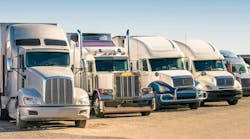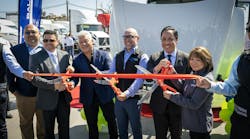It’s clear as a cloudless blue sky that the prospects are excellent for natural gas—in its compressed (CNG) and liquefied (LNG) forms—to blossom into trucking’s ultimate alternative vehicle fuel for the foreseeable future.
What’s not so obvious right now for over-the-road fleets is exactly how they can go green while saving greenbacks if they can’t find CNG or LNG fuel stations where their trucks must roll.
At present, there seems to be a classic chicken-or-egg scenario in place. Not surprisingly, fleets are unwilling to invest in natural gas-fueled trucks to run routes lacking fuel stations. On the other hand, why would fuel infrastructure tailored to commercial vehicles be built where no such trucks are rolling on nearby roads?
The answer to this seeming paradox, say experts in the field, is deceptively simple: A fleet that wants the benefits of switching to CNG or LNG should investigate the requisite trucks and the necessary access to fueling at the same time.
“A common carrier can operate point to point on natural gas, but not easily just yet,” is how Erik Neandross, CEO of Gladstein, Neandross & Associates (GNA), a clean-transportation consultancy, views the present reality.
“Running on natural gas is really most feasible for fleets operating dedicated routes,” he continues. “Yet there still must be thought and considerable planning put into it right now.”
In the long run, Neandross expects fueling infrastructure to “grow organically, especially in states that provide incentives to the industry. The infrastructure will expand geographically as more fleets realize how they can save money with natural gas and that have customers interested in seeing them switch” to what’s regarded as a greener fuel.
“The infrastructure itself,” he points out, “will be built by fuel suppliers that recognize fleets are running in a given market—or the fleets will build it themselves.”
As for fleets opting to set up fuel stations, Neandross advises that a trucking company that becomes the “anchor fleet”—the one that elects to have one or more fuel stations built for it at its terminals or at roadside sites it controls—will “get the best price from the supplier on the fuel dispensed” vs. the subsequent fleets that elect to fuel up at those stations that offer public access.
“That is the model that will drive the expansion of the fuel infrastructure for natural gas trucks,” he adds. “Ultimately, it will be the long-haul fleets that will make the widespread availability of CNG and LNG on the road happen.”
Offering a fleet perspective, Scott Perry, Ryder System’s vice president of supply management, reasons that “if the question is can it be done, then, yes, it can be done. But it now requires quite a bit of planning to run long routes on natural gas.”
On the other hand, he allows that “the network is becoming more efficient every month with each new station that opens. The CNG infrastructure is more mature, but there is quite a bit of LNG infrastructure that is being put into place and is ‘ready to open’ as the demand for it grows.”
Perry regards fuel infrastructure as “an area of opportunity as there’s a misconception that there are more than 1,300 active natural gas fuel stations that will support heavy commercial vehicles. “The reality,” he elaborates, “is that there are likely less than 300 stations that are truly capable of accommodating a combination tractor-trailer and delivering natural gas at a pressure and volume required by today’s modern fuel-storage systems.
“The stations must also be able to dispense through a system that’s capable of accepting a fleet fuel card—as that allows for the capture of all of the elements of the transaction (unit number, odometer, gallons, and total transaction value) required to support the integrated back-office systems that have been integrated into fleet operations across the industry,” Perry adds.
Challenges
While he says many of the most recent station builds have taken these needs into consideration—and they’re a given at truckstops dispensing natural gas—“most of the older, existing stations are often challenged to meet all of these critical requirements to make the overall refueling process as efficient as possible.”
“There are examples of companies that have taken natural gas tractors across the country,” says Drew Cullen, vice president of fuels & environmental affairs for Penske Truck Leasing. “But the number of open and operating fueling stations on a route, out-of-route miles needed to obtain fuel, and distances between fueling stations can make the effort challenging.”
Cullen forecasts that the fueling infrastructure will “grow proportional to the adoption of natural gas vehicles by fleets.” What’s more, he says what fleets decide about CNG and LNG will be “driven primarily by the economic and environmental benefits natural gas vehicles provide along with operational considerations (e.g., range, weight, etc.).
“The infrastructure improvements will continue,” he adds, “as long as the price difference between diesel fuel and natural gas is sufficient to provide enough savings to overcome the incremental costs of the vehicles for fleets.”
Clean Energy Fuels, which operates CNG and LNG fuel stations, “and other natural gas fuel providers have together made it possible for heavy-duty truck fleets to travel virtually every major corridor across the country,” states public relations manager Patric Rayburn. “Eighty-five percent of over-the-road trucking takes place over such regional corridors and our network is fueling many of those trucks today.”
Rayburn points out that Clean Energy “partnered with Pilot Flying J, the largest truckstop operator in the country, to co-locate our natural gas fueling stations at their existing truckstops to make the transition to natural gas as convenient as possible for truckers.”
And he says there is ample evidence that, with forethought and planning, fleets can run cross-country on either CNG or LNG.
“For example,” Rayburn relates, “our long-time customer Saddle Creek Logistics Services recently ran on CNG from Florida to California and back, making deliveries for Procter & Gamble and Lowe’s along the way. The truck had no issue finding stations along the routes.”
Rayburn also notes that another fleet customer, El Paso-based EJ Madison, is now fueling its LNG-powered tractors for coast-to-coast runs via Clean Energy stations.
“We solved the chicken/egg conundrum by building a nationwide network and by helping our customers at the various stages of their natural gas transition—from truck orders to deployment to fueling,” he remarks.
“The infrastructure is in place and will be expanded as demand increases,” adds Rayburn. “Our approach is to listen to our customers and provide the fueling solution that best meets their fleet needs, whether that’s CNG or LNG.”
Developing pattern
Bill Zobel, vice president of market development & strategy for Trillium CNG, characterizes the current status of over-the-road fueling infrastructure as “an ongoing question—and not one that will be answered soon. Right now, there are 110,000 fueling stations out there, but less than 1% is equipped for CNG or LNG.
“On the other hand,” he continues, “an uptick in activity has occurred in the last year or so. Market projections we’ve seen indicate that some 200 natural gas stations aimed at over-the-road operators will be installed this year and from 200 to 400 will be built in subsequent years. Most of these will be for CNG, with LNG accounting for a fraction.”
What Zobel describes as “the developing pattern” finds the fueling market moving beyond serving domiciled fleets, which are centrally fueled, to providing access to natural gas on or near major highways for longer-haul operations.
He says Trillium will either build fuel stations for fleets to own or will contract with fleets to build ones that Trillium will own. In either case, the stations are located at sites selected by the fleets. In the latter case, notes Zobel, the contracts fleets ink with Trillium will give them “a great price on the fuel as well as fuel discounts offered nationally wherever our [public] stations are.”
As for dealing with that chicken and egg, Zobel advises that fleet owners “consider taking an integrated approach as it won’t be a one-stop-shopping process. They will need to look into the vehicles and, at the same time, analyze what fueling infrastructure they will need, including whether they will access public sites or have stations installed for them.
“Fleets should be aware that a lot of the fuel stations now being built are designed to address the Class 8 over-the-road market,” he continues. “These stations can accommodate tractor-trailers in several lanes, accept fuel cards for payment, and have equipment that can fuel at the fast rate of 10-plus gal./min.”
“Think about this,” says Michael Hosfeld, Midwest sales director for TruStar Energy, which specializes in CNG fueling equipment, “in 2007, virtually no regional or long-haul operation of CNG-powered tractors was feasible. But, today, regional hauling is extremely feasible in many markets.”
Hosfeld sees CNG “continuing to grow as the primary alternative fuel choice nationwide. In markets where no pipeline gas is available, LCNG [liquefied compressed natural gas] will likely be the favored option over LNG.”
As to why CNG will dominate, Hosfeld maintains that “the natural gas supply for CNG is an open and competitive market regionally and nationally. LNG is far more monopolized, has processing cost, the cryogenic factor, expense of transport, added equipment and infrastructure, and specialized handling resulting in a considerably less green footprint.”
He says those factors will keep CNG “30% to 50% cheaper per gallon for the foreseeable future. At expos, regional shows and in discussions with major fleets nationwide, [we have found] very few are focused on LNG as their primary choice of natural gas fuel.
“Trucks designed to run on CNG are already fueling nationwide at stations using pipeline gas for about $2/gal.,” he continues. “In remote locations liquid gas will be dispensed. Like LNG, LCNG cost 60¢ to $1 more in these remote locations. Fleets will do all they can to purchase CNG at $2 from stations tethered to the pipeline. However, when they have no alternative, they will use LCNG and pay $2.60 to $3/gal. That is still significantly better than $4/gal. diesel.”
Partnering
Growth in public-access fuel stations—at a rate of a “few hundred locations a year”—will be pushed by “a multifaceted approach,” predicts Hosfeld. “Stations will be built through partnerships with fleets as well as by traditional retailers [such as at truckstops] along with ones put up by private fleets and public entities.”
As one example of how the infrastructure will be built out, he points to the partnership CNG station TruStar is currently building in Ft. Myers, FL, that will be open to the public.
“Our anchor partner is J.J. Taylor, a major beverage distributor in the Florida and Minnesota markets,” he explains. “Their CNG trucks will fuel at this station. They agree to use the station and we capitalize, design, build, own and operate the station. The bonus is the station will be open to the public. Everyone will benefit from a station that would not have been built otherwise.”
“Our approach to the market is to partner with fleets willing to purchase their CNG fuel from us,” says Bill Renz, general manager of Gain Clean Fuels.
“For our part, we put in turnkey stations that we own, operate and maintain to fuel their trucks,” he continues. “A fleet will typically sign a 10-year agreement with Gain to purchase a minimum amount of CNG fuel from us at our stations. Each fleet that signs with us shares in the profitability at the site, as each one we build is open to the public as well.”
The Gain-built stations are located at sites offering easy on/off Interstate access and are designed to accommodate tractors with 55-ft. trailers. They are open 24/7/365 and accept national fleet cards for payment.
Renz relates that the firm has inked such deals with several over-the-road fleets that he cannot name at this point. “One fleet is starting out with five locations and is planning to add five after that to map out the fueling infrastructure for the route network they run.”
GNA’s Neandross advises that there are various highway corridors along which CNG and/or LNG fuel stations are being developed at fairly steady paces. These include I-15 from Los Angeles to Salt Lake City for both CNG and LNG, in part because of UPS natural gas trucks running that stretch; I-5, particularly in California; and I-75 from Chicago to Florida.
In addition, he regards the I-40/I-10 corridor from Southern California into Texas as “perhaps the next to develop” and notes that corridors in the “Texas Triangle” will see “infrastructure come together nicely this year resulting in thousands of trucks being deployed.”
Along the way
According to TruStar’s Hosfeld, CNG infrastructure is already well represented in many markets. “These include the...entire states of Wisconsin, Minnesota and Iowa as well as in the Chicago, Pittsburgh, and Akron and Columbus, OH, areas,” he relates. “There are also numerous locations in Georgia and Florida as well as in Salt Lake City, Oklahoma City, Kansas City, and Omaha and Lincoln, NE, among others.”
“These markets all have large public access stations,” he continues. “It is not yet feasible to efficiently travel nationwide [on CNG] as there remain many station gaps to be filled.”
Trillium’s Zobel says the most robust CNG infrastructure for Class 8 trucks currently can be found in the upper Midwest and Texas, followed by the Southeast as well as the lower Midwest to the West Coast and also on the Los Angeles/Salt Lake City run.
“Currently,” he adds, “we operate 65 CNG stations. Of those, 35 provide public access to fueling and the other 30 are private ‘behind-the-fence’ stations. And we have another 26 locations under contract. Our stations can be found around the country.”
Gain’s Renz says that the supplier aims to be active in the CNG fueling market through fuel stations located along major highways near such key cities as Chicago, Indianapolis, Gary (IN), Des Moines, Columbus (OH), Dallas, St. Louis and Denver. “In the field, we have nine business-development managers to cover the entire country, as our mission is to create a nationwide CNG network for truck fleets to access,” he points out.
“We have nine sites in place so far and plan to build another 30 sites over the next year,” Reinz adds. “And each of these will be guaranteed to be operating for at least 10 years [via the contracts the firm signs with anchor fleets].”
“Companies that build and operate natural gas fueling infrastructure need a sufficient volume commitment to justify their investment,” observes Penske’s Cullen.
He says that “fleets looking to adopt natural gas vehicles need to be convinced that the economic, environmental, and operational benefits are sufficient to replace their current fleet with natural gas vehicles. In order for an accelerated adoption of natural gas vehicles to take place, both the fueling infrastructure companies and the fleets must work together to ensure these benefits will be realized.
“And fleets that have done sufficient analysis to ensure they will realize the economic and environmental benefits of natural gas vehicles must work with companies building the fueling infrastructure to ensure sufficient coverage along highway corridors,” Cullen continues.
He adds that ideally both the trucking and fueling infrastructure should be in place at the same time “to ensure the economic benefits are being maximized for both parties.”
“We haven’t seen a shortage of players willing to invest in the fueling infrastructure, but they do want to make sure that they are planting this infrastructure in markets and corridors that will have the greatest possible potential for generating throughput,” says Ryder’s Perry. “Most station developers are looking for an anchor fleet or fleets to help consume some portion of the initial capacity.
“The best way for the market to grow as efficiently as possible is for the parties—fleets and fuel infrastructure providers—to meet and talk realistically about needs and expectations for the long term, meaning their needs over the next 48 to 72 months as their fleets grow,” he advises.
Perry contends that “giving station providers a much better understanding of the demands of the market allows them to properly size stations on the front end of the equation, as opposed to finding out their station is ‘tapped out’ 12 months after it was commissioned. Compression capacity is not infinite.”
As to whether the long-haul trend will ultimately swing heaviest in favor of CNG or LNG, Trillium’s Zobel contends that “it’s anybody’s guess which will ultimately pull head.”
However, he does suggest glancing in the rearview mirror at what happened with transit buses and refuse trucks, whose owners first went with LNG due to its appeal as a liquid fuel.
“When the engine and other technology evolved, those bus and truck operators switched to CNG because it is more efficient, easier to fuel with, and its supply line is simpler,” says Zobel. “Over time, I expect over-the-road trucking will move to CNG as well.”



